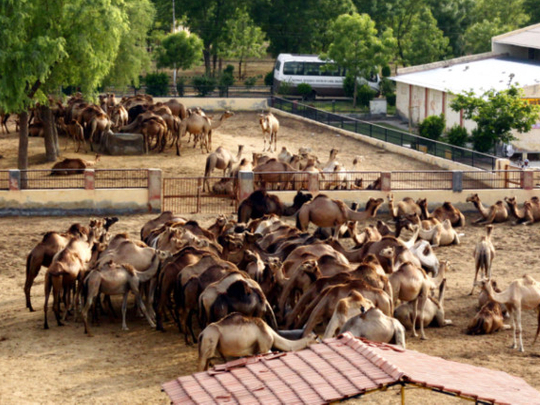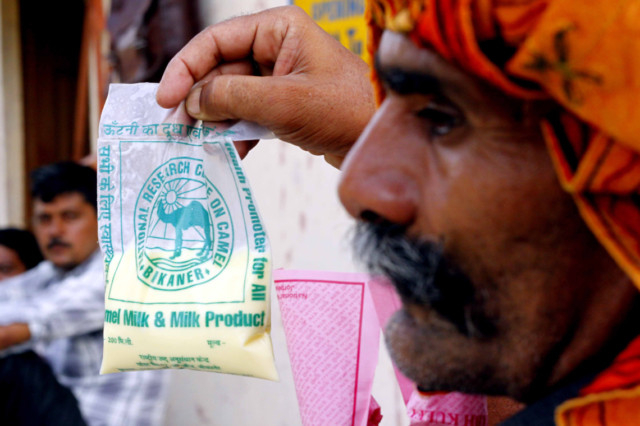
The sleepy cities of the Thar desert are waking up to the nutritional and medicinal benefits of camel milk.
After having demonstrated that drinking camel milk brings about a significant reduction in the dosage of insulin required to maintain long-term glycaemic control among Type 1 diabetes patients, scientists at National Research Centre on Camel (NRCC), India’s only camel breeding farm, spread over 689 hectares, in Bikaner, in northwestern Rajasthan, are now hoping for other discoveries about the animal that could convince its custodians to not give up raising it. As part of a World Bank-funded project, NRCC is working on identifying the gene responsible for the camel’s adaptability in extreme temperatures in the summers — when it can go without water for six-seven days. The centre is also working on developing vaccines and diagnostic drugs for tuberculosis and cancer.
NRCC has been promoting the nutritive and therapeutic properties of camel milk for many years, but camel milk supply is limited since 90 per cent of the camel population in Rajasthan — roughly 420,000 — is found in the northwestern regions such as Bikaner. It is for this reason that NRCC is developing camel milk powder to increase its functional food value.
“For the past one year, we’ve been trying to establish that milk powder does not lose its nutraceutical value after heat is applied to produce it,” says. NRCC, a premier research centre of the Indian Council of Agricultural Research (ICAR), which is an autonomous organisation under the federal government’s Ministry of Agriculture, works for conservation and improvement of four breeds of the Indian dromedary — Bikaneri, Jaisalmeri, Mewari and Kachchhi.
Two years ago, NRCC saw the birth of a white female calf, a first in centre’s 29-year history. Zoologists are euphoric, for this rare white Mewari calf can now be used to breed new varieties of camels. The birth was also significant because the Mewari breed is facing extinction — there were only 8,800 Mewari camels out of the country’s 561,828 camels in 2007, when the last livestock census was conducted.
Sturdy Mewari camels are particularly useful for milk production. Mewari camels give around seven to eight litres of milk per day, compared to five to six litres by other common breeds such Jaisalmeri and Bikaneri.
The NRCC website says, “The proverbial Ship of Desert earned its epithet on account of its indispensability as a mode of transportation and drought power in desert but the utilities are many and are subject to continuous social and economic changes.”
For one, camels have special antibodies in their bloodstream that are capable of destroying harmful bacteria and viruses or neutralising other disease-causing poisons and pathogens. In medical circles, these antibodies are generally described as “nano antibodies” because of the speed with which these can travel through the animal or human body to reach the spot where they are needed.
NRCC director Dr Patil says that the antigen-antibody reaction in camels is similar to that in human beings, and for this reason, these antibodies, if harvested, can be used as a defence mechanism. “The antibodies need to be modified with biotech tools. We have been able to harvest such antibodies, purify them and test them on mice and rabbits,” he adds.
NRCC is collaborating with the Bhabha Atomic Research Centre (Barc), Mumbai, to evaluate the effectiveness of antibodies in diagnosing and treating diseases such as tuberculosis and thyroid cancer. But, Patil says, it will take six to seven years before these products can be introduced in the market.
Now the NRCC has been allotted Rs15 crore (Dh8.9 million) as part of the 12th Five-Year Plan for this project.
But NRCC began research sometime in 2003 when it decided to study the “insulin-like” properties of camel milk. In 2005, doctors from SP Medical College and former NRCC director M.S. Sahani published a paper in the Journal of Camel Practice and Research titled “Effect of raw camel milk in Type 1 diabetic patients: one-year randomised study”.
The research studied the efficacy of camel milk consumption as an adjunct to routine diabetic management in maintaining long-term glycaemia control among Type 1 diabetes patients. During the 52-week randomised study, 12 patients underwent routine diabetic management (diet, exercise and parental insulin supplementation) while another group of 12 patients additionally had 500 millilitres of raw camel milk daily. Camel milk was found to contain approximately 52 micro units/millilitre insulin and it might have been the reason for a lesser requirement of insulin the second group.
Two years later, Dr R.P. Agrawal and others from Bikaner Medical College proved zero prevalence of diabetes in the Raika community, whose diet includes camel milk.
Two thousand and ninety-nine participants from different villages of northwestern Rajasthan were selected using stratified sampling of a representative Raikas and non-Raikas, those consuming or not consuming camel milk. No one from the Raika community who had camel milk was a diabetic.
A government veterinary doctor posted at Kalu, in Lunkaransar tehsil of Bikaner, Dr Suresh Kumar, validates the result. “This area is largely inhabited by people of the Raika community, who are traditional camel breeders,” he says. “I was surprised to find out that no one in their families, in last few generations, ever had diabetes.”
Now, Defence Research Development Organisation (DRDO) and Indian Council for Medical Research (ICMR) are conducting field trials before camel milk can be standardised for Type 1 diabetics. But, today, almost half of the camel milk produced daily at NRCC is sold to diabetic patients at the centre at the subsidised rate of Rs15 a litre.
At an international seminar, The Camel in Rajasthan: From Heirloom to Unique Selling Point, in April 2008, camel expert from Dubai Dr Uli Wernery described camel milk as more valuable than oil. He predicted because of global warming, cows may stop producing milk and camels may be left as the only source of milk.
The seminar was hosted by Pali-based non-governmental organisation, Lokhit Pashu-Palak Sansthan (LPPS), which started working with camel breeders in Pali district in 1994. In fact the organisation was specifically set up to address some of the complaints by Raika camel herd owners about the lack of veterinary care and problems of grazing in the Aravalli Range that had come to light during an earlier research project. Since then, LPSS has been working with camel herd owners to make them aware of the potential of camel milk and organise them for marketing, but it hasn’t taken off.
Patil says there are a lot of social and religious taboos related to selling camel milk. “Their religious leaders tell them that if they sell camel milk, it will destroy the species,” he says.
The production at NRCC is insufficient to meet the requirement of the processing unit, which has a minimum capacity of 5,000 litres, and it wants farmers to take up dairy production. “Camel milk has in it several nutritional advantages,” Patil explains. “The moisture and protein content is much higher than in cow’s milk. Also, it has a low percentage of total solids and fat and contains a higher concentration of insulin along with higher values of trace minerals.”
The problem, some say, is that it has a smell and is difficult to consume unless it is flavoured and pasteurised.
NRCC has been identified as a tourist landmark of Bikaner. Tourists can see camels of different breeds and their behaviour. A camel museum apprises them of the research aspects of the camel in the desert ecosystem. Camel milk products such as ice-cream, hot and cold beverages, is a big draw for tourists.
Rakesh Kumar is a writer based in Jaipur, India.



